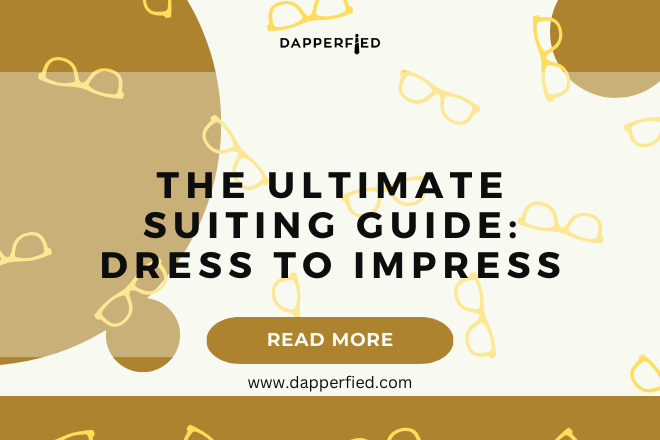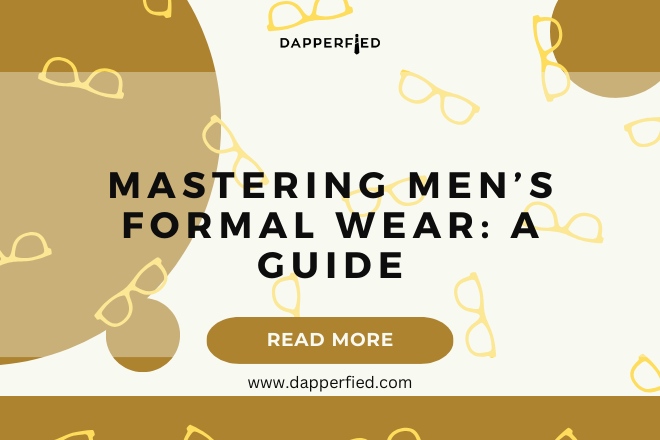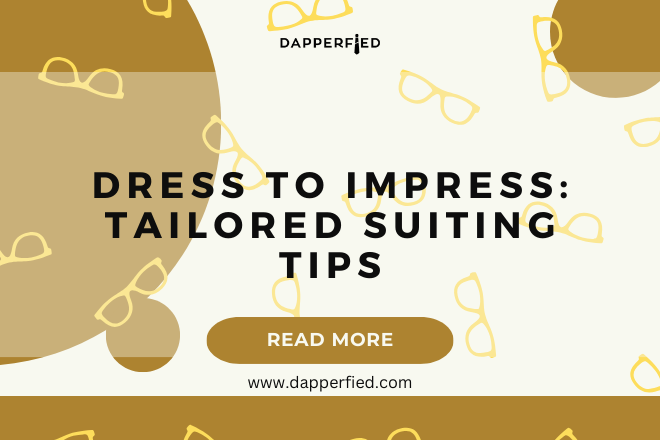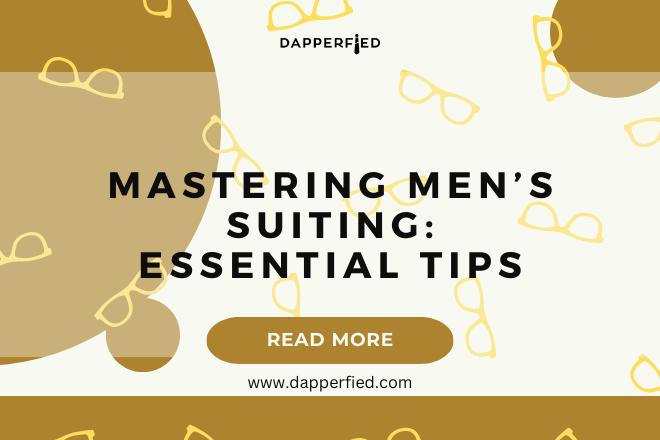
Men's Style
Mastering Men’s Suit Shopping: Your Ultimate Guide
Having a well-fitted suit is essential for various occasions, whether it’s a job interview, a wedding, or a formal event. A suit that fits perfectly not only enhances your appearance but also boosts your confidence. However, finding the right suit can be a daunting task if you don’t know what to look for. That’s why mastering men’s suit shopping is crucial. It not only saves you time and money in the long run but also ensures that you always have the perfect suit for any occasion.
When you have a well-fitted suit, you exude an air of professionalism and sophistication. It shows that you take pride in your appearance and pay attention to detail. Whether you’re attending a business meeting or a social event, a well-fitted suit can make a lasting impression. On the other hand, wearing an ill-fitting suit can give off the wrong impression and make you feel uncomfortable throughout the day.
Mastering men’s suit shopping can also save you time and money. When you know exactly what to look for in a suit, you can quickly narrow down your options and make an informed decision. This eliminates the need to try on multiple suits or visit numerous stores. Additionally, investing in a high-quality suit that fits well will save you money in the long run as it will last longer and require fewer alterations or replacements.
Key Takeaways
- Mastering men’s suit shopping is important for any man who wants to look sharp and put-together.
- When choosing a suit, consider factors such as fit, style, and occasion.
- Classic, modern, and contemporary styles offer different options for different tastes and occasions.
- Tailoring your suit can ensure the perfect fit and make you feel confident and comfortable.
- Understanding fabric and material, as well as accessorizing and maintaining your suit, are key to completing your look and keeping it looking sharp.
Suit Selection Tips: How to Choose the Perfect Suit
Choosing the perfect suit involves considering several factors such as the occasion, body type, and personal style. Firstly, consider the occasion for which you need the suit. Different occasions call for different levels of formality, so it’s important to choose a suit that aligns with the dress code. For formal events such as weddings or black-tie affairs, opt for a classic black or navy suit. For more casual occasions, such as business meetings or daytime events, you can experiment with different colors and patterns.
Next, consider your body type. Different suit styles flatter different body types. For example, if you have a slim build, a slim-fit suit will accentuate your physique. On the other hand, if you have a larger build, a regular or classic fit suit will provide a more comfortable and flattering look. It’s important to try on different styles and sizes to find the one that fits you best.
Lastly, consider your personal style. Your suit should reflect your personality and make you feel confident. If you prefer a more traditional look, opt for a classic suit with minimal patterns and a neutral color. If you like to make a statement, experiment with bolder colors or patterns. Ultimately, choose a suit that makes you feel comfortable and confident.
Men’s Suiting Styles: Classic, Modern, and Contemporary
Men’s suits come in various styles, each with its own unique characteristics. The classic suit is timeless and never goes out of style. It features a single-breasted jacket with two or three buttons and straight-leg trousers. This style is suitable for formal occasions such as weddings or business meetings.
The modern suit is a more streamlined version of the classic suit. It features a slimmer fit and shorter jacket length. The trousers are also slimmer and often have a shorter break. This style is popular among younger men and is suitable for both formal and semi-formal occasions.
The contemporary suit is the most fashion-forward style. It features unique details such as peak lapels, ticket pockets, or contrasting buttons. This style allows for more experimentation with colors, patterns, and fabrics. It is suitable for fashion-forward events or occasions where you want to make a statement.
Tailored Suit Guide: Customizing Your Suit for the Perfect Fit
| Metrics | Values |
|---|---|
| Number of customization options | Over 100 |
| Average time to create a tailored suit | 4-6 weeks |
| Number of fittings required | 2-3 |
| Price range | 800-5000 |
| Types of fabrics available | Wool, cotton, linen, silk, cashmere |
| Types of suits available | Single-breasted, double-breasted, three-piece |
| Types of lapels available | Notch, peak, shawl |
| Types of pockets available | Straight, slanted, patch, flap |
| Types of vents available | Center, side, no vent |
| Types of buttons available | Horn, mother-of-pearl, metal |
Getting a tailored suit is the best way to ensure the perfect fit. A tailored suit is made specifically for your body measurements, resulting in a fit that is unmatched by off-the-rack suits. The benefits of a tailored suit include enhanced comfort, improved appearance, and increased confidence.
To get the perfect fit for a tailored suit, you need to start with accurate measurements. It’s best to have a professional tailor take your measurements to ensure accuracy. The key measurements include the chest, waist, hips, shoulders, sleeve length, and trouser length. These measurements will determine the overall fit of the suit.
Once you have your measurements, you can customize various aspects of the suit to achieve the perfect fit. This includes adjusting the jacket length, sleeve length, trouser length, waist suppression, and shoulder width. A skilled tailor will be able to make these adjustments to ensure that the suit fits you like a glove.
Suit Buying Tips: What to Look for When Shopping for a Suit
When shopping for a suit, it’s important to check the quality of the suit to ensure that it will last and maintain its appearance over time. Start by examining the stitching. The stitching should be neat and even throughout the suit. Loose or uneven stitching is a sign of poor quality.
Next, check the lining of the suit. A high-quality suit will have a full lining that extends throughout the jacket and trousers. The lining should be smooth and well-constructed. It should also have functional pockets.
Another important aspect to consider is the buttons. The buttons should be securely attached and made of high-quality materials such as horn or mother-of-pearl. Cheap plastic buttons are a sign of low-quality craftsmanship.

In terms of fit, pay attention to the shoulder fit. The shoulders should lie flat and not extend beyond your natural shoulder line. Additionally, check the sleeve length. The sleeves should end at your wrist bone when your arms are relaxed by your side. Lastly, check the trouser length. The trousers should have a slight break at the front and should not be too long or too short.
Men’s Formal Wear: From Black Tie to Business Attire

Men’s formal wear encompasses various levels of formality, each with its own specific dress code. Black tie is the most formal dress code and typically requires a tuxedo. A black or midnight blue tuxedo with a white dress shirt, black bow tie, and black patent leather shoes is the standard black tie attire.
Semi-formal attire is less formal than black tie but still requires a suit. A dark-colored suit with a dress shirt, tie, and leather shoes is appropriate for semi-formal occasions such as weddings or cocktail parties.
Business attire is the most common dress code for professional settings. It typically requires a suit in a neutral color such as navy or gray. A dress shirt, tie, and leather shoes complete the business attire look.
Fabric and Material: Understanding the Differences and Choosing the Right One
The fabric and material of a suit play a significant role in its overall appearance and comfort. The most common fabric used in men’s suits is wool. Wool suits are versatile, breathable, and durable. They are suitable for year-round wear and can be worn in both formal and casual settings.
Cotton suits are lightweight and breathable, making them ideal for warmer climates or summer events. They have a more casual look compared to wool suits and are often worn for less formal occasions.
Linen suits are perfect for hot weather as they are lightweight and breathable. However, linen wrinkles easily, so it may not be suitable for more formal occasions.
Other materials used in men’s suits include silk, cashmere, and synthetic blends. Silk suits have a luxurious appearance but require special care. Cashmere suits are incredibly soft and warm but tend to be more expensive. Synthetic blends offer affordability and durability but may lack the natural breathability of wool or cotton.
When choosing the right fabric and material for a suit, consider the occasion, season, and personal preference. Opt for wool or cotton for versatility and comfort, and reserve linen or silk for specific occasions or climates.

Accessories: How to Complete Your Look with the Right Shoes, Tie, and Pocket Square
Accessories play a crucial role in completing a suit look. The right shoes, tie, and pocket square can elevate your outfit and add a touch of personality. When choosing shoes, opt for classic styles such as oxfords or brogues in black or brown. The shoes should be well-polished and match the formality of the suit.
The tie is an opportunity to add color or pattern to your outfit. Choose a tie that complements the color of your suit and shirt. For formal occasions, opt for a silk tie in a solid color or subtle pattern. For more casual events, you can experiment with bolder colors or patterns.
A pocket square adds a finishing touch to your suit jacket. It should complement the colors in your outfit without being too matchy-matchy. Fold the pocket square neatly and place it in your jacket pocket for a polished look.
Maintenance and Care: Keeping Your Suit Looking Sharp and Fresh
Proper maintenance and care are essential to keep your suit looking sharp and fresh. Start by cleaning your suit regularly. Most suits can be dry cleaned, but it’s important to follow the care instructions on the label. Avoid excessive dry cleaning as it can cause the fabric to wear out faster.
When storing your suit, hang it on a sturdy wooden hanger to maintain its shape. Avoid using wire hangers as they can stretch the shoulders of the suit. If you’re traveling, invest in a garment bag to protect your suit from wrinkles and damage.
Ironing is another important aspect of suit care. Use a steam iron on a low setting to remove wrinkles. Avoid using too much pressure or high heat as it can damage the fabric. If you’re unsure about ironing your suit, take it to a professional cleaner or tailor.
Putting It All Together and Mastering Men’s Suit Shopping
Mastering men’s suit shopping is a valuable skill that can save you time and money while ensuring that you always look your best. By considering the occasion, body type, and personal style, you can choose the perfect suit that fits well and reflects your personality. Tailoring your suit for the perfect fit and paying attention to the quality of the suit are also important factors to consider.
Understanding the different levels of formality in men’s suits and choosing the right fabric and material for different occasions and seasons are crucial aspects of mastering men’s suit shopping. Completing your look with the right accessories and properly maintaining and caring for your suit will ensure that it always looks sharp and fresh.
By applying the tips and advice provided in this article, you can confidently navigate the world of men’s suit shopping and always be prepared for any occasion. Remember, a well-fitted suit not only enhances your appearance but also boosts your confidence, making you feel ready to conquer any challenge that comes your way.
If you’re looking for more fashion tips to complete your dapper look, check out this article on men’s ties fashion tips. It offers valuable insights on how to choose the right tie to complement your suit and enhance your overall style. And if you’re on a budget but still want to look sharp, this discussion on affordable suits is a must-read. It provides practical advice on finding high-quality suits without breaking the bank. Lastly, if you’re in the mood for some inspiration and want to explore cool and unique suit options, this article on cool men’s suits will surely catch your attention. Happy shopping!
FAQs
What should I consider when buying a men’s suit?
When buying a men’s suit, you should consider the fit, fabric, style, and occasion. The fit should be tailored to your body type, the fabric should be appropriate for the season and occasion, the style should match your personal taste, and the occasion should dictate the level of formality.
What are the different types of men’s suits?
There are several types of men’s suits, including single-breasted, double-breasted, three-piece, and tuxedos. Single-breasted suits have one row of buttons, while double-breasted suits have two rows. Three-piece suits include a vest, and tuxedos are typically worn for formal events.
What is the difference between a slim fit and a regular fit suit?
A slim fit suit is more fitted to the body than a regular fit suit. Slim fit suits have a narrower cut through the chest, waist, and hips, while regular fit suits have a more relaxed fit. Slim fit suits are more modern and fashionable, while regular fit suits are more traditional.
What fabrics are commonly used for men’s suits?
Common fabrics used for men’s suits include wool, cotton, linen, and synthetic blends. Wool is the most popular fabric for suits because it is durable, breathable, and versatile. Cotton and linen are more lightweight and breathable, while synthetic blends are more affordable.
How should a men’s suit fit?
A men’s suit should fit snugly but not be too tight. The jacket should fit well in the shoulders and chest, with the sleeves ending at the wrist bone. The pants should fit comfortably in the waist and hips, with a slight break at the ankle. The length of the jacket and pants should be appropriate for your height.


















